Oxfordshire
OXFORD
Visitors to Oxford are advised to use the Park and Ride system. Cars are not welcome and parking space is scarce and expensive.
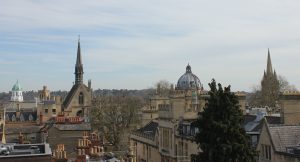
Oxford from St Michael's tower
Despite many attempts to manage traffic, noise and air pollution in the High Street area is still a problem. But get into the gardens, quads and parks to enjoy some of the most beautiful buildings in England.
Oxford is all things to all people. For some it is a powerhouse of ideas and a training ground for the nation's elite. Just one college - Magdalen - claims seven Nobel prizewinners among its former Fellows. Others see Oxford as an intellectual backwater, an oasis of nostalgic dreamers, which has consistently backed the wrong cause - from Charles I in the Civil War to the ill-fated peace movements of the nineteen thirties. In 1965, James Morris wrote Oxford is a Christian city, built upon the Christian culture - as organically Christian as Bangkok is Buddhist.. Oxford was never a pagan settlement. She was born Christian, grew up Christian and remains half Christian still. For the last eight hundred years, men whose lives have shaped the church in England and across the world have studied, taught, prayed, preached and even been martyred here. The pulpits, cloisters, lecture halls and common rooms have echoed to the sound of debate and discussion, declaration and denunciation. [Walking tours to places of interest for Christian heritage are organised by www.zenasheritagetours.com]
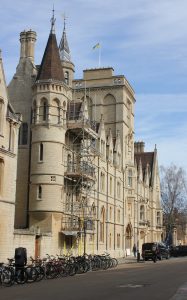
Balliol College
John Wycliffe (1324-1384) came here as Master of Balliol College in the fourteenth century and described Oxford as a Vineyard of the Lord. A century and a half later, the intellectual whirlwind unleashed by his teachings reached a tragic climax with the trial and burning of the leading reformer bishops Hugh Latimer, Nicholas Ridley and Thomas Cranmer under the auspices of the Catholic Queen Mary. It happened in Broad Street, a few paces from Wycliffe's old college.
In the time of Cromwell, the vice-chancellor of Oxford was John Owen (1616-1683), a puritan theologian of massive intellect, whose voluminous writings on all matters of doctrine and church government are still consulted today. Another puritan, Thomas Goodwin (1600-1680) was President of Magdalen College at this time and a frequent preacher at the university church of St Mary.
In 1720, the young John Wesley arrived at Christ Church College. He gathered around him a group of serious-minded young men, who were nicknamed the "Holy Club" or "Methodists" by their more worldly colleagues. They combined fervent prayer, often in the open air, with works of charity to prisoners and the poor. As yet, some were still vague on the meaning of salvation, but when that was finally resolved the evangelical revival began in earnest.
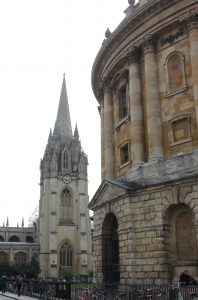
St May's and the Radcliffe Camera
Nineteenth century Oxford saw the start of a movement of a quite different kind. Shaken by the industrial revolution and the challenge of the Methodists, the Church of England seemed uncertain which path to follow. In 1833, John Keble (1792-1866) preached the Assize sermon at St Mary's. Stressing the historic continuity of the Anglican church with Rome, he called for a greater emphasis on ritual, liturgy and the sacraments. The cry was taken up by his colleagues Edward Pusey (1800-1882) and John Henry Newman (1801-1891), all three Fellows of Oriel College. They expressed their views in a series of papers called Tracts for the Times and the whole Romeward slant became known as the Tractarian or Oxford Movement. It split parishes and even families into "high" and "low" church factions and the effects are still felt today.
Even the secularism of the twentieth century was challenged by Oxford. C. S. Lewis (1898-1963), a Fellow of Magdalen College, described how he moved from atheism to belief in God while travelling on a bus up Headington Hill in 1929, at first an extremely reluctant convert. He gradually found his way back to the Anglican church and employed his formidable intellect as a Christian apologist, as well as writing literary criticism, science fiction and the allegorical Narnia books for children.
Cornmarket Street
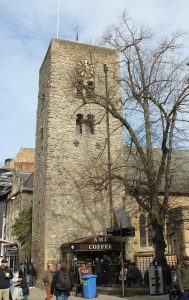
St Michael's Northgate
We can begin in the centre. Cornmarket Street is now mercifully traffic-free, but has still been voted one of the least attractive streets in Britain. It links the High Street and St Aldate's to Broad Street and St Giles. Most places of interest are within easy walking distance from here.
The Saxon tower of St Michael's at the Northgate is the oldest building in Oxford. For a small charge we can climb to the top for an excellent view of the city, with panoramic diagrams to identify spires, domes and colleges. The church's clock and bells and its collection of silver can be seen in the tower. Also on display is the door of a cell from the Bocardo Prison, which used to stand adjacent to the church and was demolished in 1771. It was behind this door that the martyr bishops Latimer, Ridley and Cranmer were imprisoned prior to their executions in 1555-56. The prison was also the scene of charitable visits by members of the Holy Club, including John and Charles Wesley and George Whitefield. A plaque on the pulpit records that John Wesley preached the Michaelmas sermon here in 1726, as a newly elected Fellow of Lincoln College.
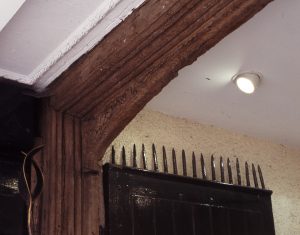
Golden Cross Inn entrance
Prior to their incarceration in the Bocardo, Cranmer, Latimer and Ridley were all held for a time at the Golden Cross Inn, in chambers known for centuries as the Martyrs' Rooms. This lies a little way down towards the High Street on the same side as St Michael's. The area has now been transformed into the Golden Cross Shopping Centre, a pedestrian precinct with boutiques and pavement cafes. The inn building straight ahead, emblazoned with the words 1193 The Golden Cross is now a Pizza restaurant! At the entrance in Cornmarket Street, the wooden door jambs and lintel look medieval and could well have been the ones through which the bishops passed.
Broad Street
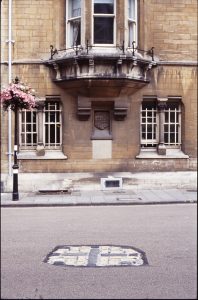
Martyrs' cross, Broad Street
The site of martyrdom is marked by a cross made with cobbles at the west end of the street. The tablet on an adjacent wall records the event, which was graphically described by the martyrologist John Foxe. Hugh Latimer, former Bishop of Worcester, and Nicholas Ridley, Bishop of London, were burned together in the ditch against Balliol on 16th October 1555, with Thomas Cranmer compelled to watch the scene from the city walls. Latimer died quickly when the powder around his neck exploded, but Ridley succumbed slowly and in great pain.
Latimer's final words, recorded by Foxe, mark a watershed in English history: Be of good comfort, Master Ridley, and play the man. We shall this day light a candle, by God's grace, in England, as I trust never shall be put out. The persecutions of Queen Mary's reign made England a Protestant nation. The burnings, whether of high-ranking bishops or humble artisans, finally convinced the English people to have done with Mary's brand of Catholicism. Her death in 1558 was greeted with relief and the long reign of her half-sister Elizabeth was considered a merciful deliverance.
Cranmer, the former Archbishop of Canterbury, was kept in the Bocardo until March 1556. He was taken to the church of St Mary the Virgin to recant publicly his Protestant views, having already signed seven recantations under fear of death. But, to the shock of the congregation, he renounced these and declared that he would thrust his hand into the flames first for writing contrary to my heart. Uproar broke out and Cranmer was hustled along to Broad Street with priests and friars shouting after him. When the fire was kindled, the 67-year-old archbishop, as he had promised, put his right hand into the flame and died bravely on 21st March 1556. Quite apart from his doctrinal views, the death of Cranmer settled a personal score for Mary as it was he who had arranged the divorce of her mother Catherine of Aragon from Henry VIII.
Martyrs Memorial
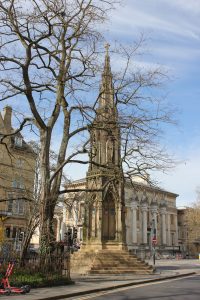
Martyrs Memorial
Designed by Sir Gilbert Scott in neo-gothic style, the Martyrs' Memorial was erected in St Giles Street in 1841-43, three hundred years after the events it commemorates. Its construction was a Protestant response to the Oxford Movement, which was at the time vigorously promoting sacramental and ritualistic practices in the Church of England. The memorial is 73 feet high with steps at the base and rises in three stages like a wedding cake. The middle stage has open canopies with statues of the three bishops. The inscription records that the three bishops died ...rejoicing that to them it was given not only to believe in Christ but also to suffer for His sake.
Ashmolean Museum
Located in Beaumont Street, close to the Martyrs' Memorial, this is one of the oldest museums in the world and, after the British Museum, has probably the best collection of antiquities in Britain.
One item in particular brings us here - the Alfred Jewel, on display in Room 35 on the first floor. Made of gold, enamel and rock crystal, this superb piece of Anglo-Saxon craftsmanship has the inscription Aelfred mec heht gewyrcan (Alfred had me made). It was probably the head of a pointer and may have been the personal possession of Alfred the Great (849-901). It was found at North Newton in Somerset in 1693.
St Giles Street
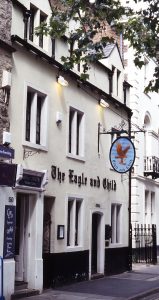
The Eagle and Child
For more than twenty years, C. S. Lewis would meet weekly with his literary friends at the Eagle and Child pub on the west side of the street. Calling themselves The Inklings, the group, which included J.R.R.Tolkien and Charles Williams, would discuss their intellectual pursuits and read aloud their latest creations. The fruits of their efforts, in which moral themes are woven around a narrative of myth and fantasy, continue to fascinate a new generation of readers and cinema audiences. The pub has several snug, wood-panelled alcoves, well-suited to such activity, but for some reason the group transferred its allegiance to the historic Lamb and Flag, immediately opposite, shortly before Lewis's death.
New Inn Hall Street
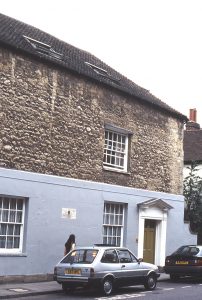
First Methodist chapel
It is difficult to avoid John Wesley in Oxford. Having preached in many of the churches and college chapels for nearly sixty years, we find him in 1783 preaching for the first time in a non-Anglican venue, in effect Oxford's first Methodist chapel. It is a low stone building, clearly quite ancient, now used as an annexe to Brasenose College. Further along the same street is the present Wesley Memorial Church (OX1 2DH) built in 1878 to celebrate the admission of non-conformists to the university. Cynics might interpret its tall spire as a Methodist challenge to the high church Anglicanism of St Mary's.
Church of St Mary the Virgin

Church of St Mary the Virgin
The University Church of St Mary the Virgin occupies a strategic position on the High Street, with colleges all around and the Radcliffe Camera just behind. It is large, with an impressive spire and barley-sugar columns on the south porch. Inside there are special pews for university officers and dignitaries on ceremonial occasions. Bullet holes caused by Cromwell's soldiers suggest a turbulent history and it has indeed provided the setting for many of Oxford's religious disputes and upheavals.
It was here that the trial of Thomas Cranmer took place, where he foreswore his former recantations and declared that he would thrust his right hand into the flames for its offence of signing them. On the north side of the nave, we can see where part of the stonework of a pillar was cut away to construct a special platform for the trial.
John Wesley preached here on several occasions, including a sermon on Salvation by Faith, shortly after his conversion in 1738. In 1744 he preached again, condemning the university for its slothfulness. His diary records I preached, I suppose, the last time at St Mary's. Be it so. I am now cleared of the blood of these men. However, the Vice-Chancellor sent for his notes, and he felt reassured that his words would not go unheeded.

Pillar damaged for Cranmer's trial
From 1828 to 1843, the vicar was John Henry Newman, renowned for his intellect, eloquence and gentleness. In 1833, the Assize sermon was preached by John Keble on the subject of National Apostasy. It was a call to revive the spiritual life of the university and the church, but it also beckoned greater emphasis on ritual and sacrament. It amounted to an appeal to the Church of England to forget the Reformation and 300 years of Protestantism and return to its historic links with Rome. This was the beginning of the Oxford Movement. While Keble remained within the Anglican fold, for Newman the path led inexorably towards Roman Catholicism, where he eventually became a cardinal. His legacy to the church as a whole was some memorable hymns, including Praise to the Holiest in the Height and Lead, Kindly Light. Keble left Oxford and spent his last thirty years in relative obscurity as vicar of Hursley in Hampshire. He died in 1866 and three years later the high church Keble College was founded in his memory.
Another preacher in troubled times was C. S. Lewis, who spoke here on at least two occasions in the early years of the Second World War. His large congregations were looking for comfort and reassurance as they sought to apply their faith to a world in turmoil.
THE COLLEGES
A word of warning. The colleges at Oxford exist to serve the needs of their students and Fellows and are not primarily visitor attractions. Some colleges allow no access unless you can convince a sceptical porter that you are an alumnus of the college or have a close family connection. Others allow visits in the afternoon, but may still be closed if examinations or conferences are in progress. Even visitor-friendly colleges may restrict access to the more interesting parts, such as the dining hall and chapel. Colleges vary greatly as to what recognition they give to former students, masters or fellows. Thus, John Wesley's time as Fellow of Lincoln is commemorated by a memorial bust, and Magdalen is keen to remind us of the link with C .S. Lewis. However, those looking for any mention of George Whitefield's time at Pembroke or Thomas Goodwin's spell as President of Magdalen are likely to be disappointed. Many of the colleges now charge for access.
Visitors should, of course, respect any notices and not attempt to enter private areas.
Christ Church College

Christ Church, Tom Tower
Founded by Cardinal Wolsey in 1525, Christ Church is one of the largest, wealthiest and most celebrated colleges. It was also the first to introduce charges for visiting the college precincts, but we are still free to use the Broad Walk and wander through the meadow. The entrance is past the main buildings, lower down St Aldate's street; those attempting to enter the quadrangle directly will be apprehended by unfriendly bowler-hatted proctors. Set in the stones at the entrance to the meadow is a quote from Bunyan's Pilgrim's Progress My sword I give to him who will succeed me in my pilgrimage, but its significance in this location is not explained.
William Penn was a student here in 1660, but after hearing a Quaker sermon he joined George Fox's Society of Friends and was obliged to resign. Two generations later, the young John Wesley arrived, small in stature but with a powerful and dominating personality. After graduation, he was ordained deacon in 1725 and returned home to Epworth for a while to serve as curate to his father. Elected a Fellow of Lincoln College in 1726 and ordained priest, he returned to Oxford in 1729. His brother Charles had entered Christ Church in 1726 and around this time, the Wesley brothers began to meet with like-minded students including William Morgan, Benjamin Ingham and James Hervey. Nicknamed the Holy Club by their sceptical companions, they devised a strict system of discipline and worship. They read a variety of theological works from the early church fathers to William Law's Serious Call to a Devout and Holy Life. In 1733, they were joined by a new member from Pembroke College, George Whitefield. The ascetic practices adopted by Whitefield and others caused some concern. Sometimes they would pray for hours in the snow in Christ Church meadows. From 1729 their meetings took place in John Wesley's rooms in Lincoln College and continued until 1735 when the members dispersed - some to America and others to country parishes.
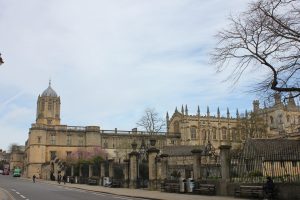
Christ Church College
In the dining hall, portraits of former graduates and fellows are displayed around the walls. Just to the left of the main door is George Romney's portrait of John Wesley. Within the precincts of Christ Church is Oxford Cathedral, which also serves as the college chapel. It is small by cathedral standards and was created after the Reformation from St Frideswide's monastery church, one of the original monastic foundations of Oxford. John and Charles Wesley were both ordained here.
Lincoln College
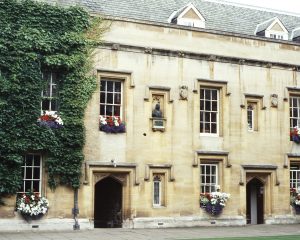
Lincoln College
Like so many of the colleges, Lincoln has an ambience which is hard to define and even harder to describe. The warm, yellow stone and creeper covered walls create an atmosphere of calm, which for some will be a stimulus to conscientious study and for others an excuse for indolence.
John Wesley's Fellowship provided him with an income of £28 a year, on which he lived for many years. He had rooms in the college from 1729 to 1735 and the meetings of the Holy Club were held here. In the nineteen twenties, American Methodists paid for the rooms to be restored to their original form with linenfold panelling and antique furniture, although one historian was unkind enough to suggest they may have chosen the wrong rooms. The traditional rooms are located over the arch between the two main quadrangles and a bronze bust of Wesley is set into the wall on the north side.
The chapel has the pulpit from which Wesley preached and glass doors have recently been installed in his memory, quoting his dying words The best of all is, God is with us. There is a portrait in the dining hall but, like the restored rooms, this is not normally open to the public.
Hertford College
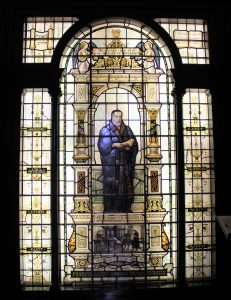
Tyndale window
The college, in Catte Street, is believed to have a contemporary portrait of Bible translator, William Tyndale (1494-1535), although he does not appear to have been a student here. There is also a stained glass window of Tyndale in the chapel, commissioned in 1904 to celebrate the centenary of the British and Foreign Bible Society. With a central picture of Tyndale and below him an early printing press, there are also the names of Bible translators from many centuries, including St Jerome (of the Latin Vulgate), Martin Luther, Henry Martyn, William Carey and Robert Morrison. The window is against a wall at the back of the chapel, so has a back light on a timer. This can be re-lit with a switch on the right.
Magdalen College
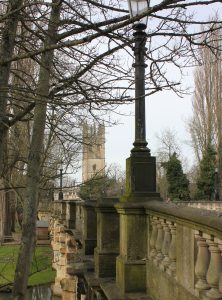
Magdalen College and Bridge
The Great Tower of Magdalen stands proudly over the eastern approach to the city. During the Civil War, Charles I's troops used it to watch for Cromwell's army, and kept a supply of stones to hurl on any attackers. On May Day morning, the choirboys sing madrigals from the top at dawn, which is generally followed by student revelry on the river below. The scene was beautifully depicted in the film Shadowlands, the story of C. S. Lewis's relationship with Joy Davidman and her young sons.
Lewis came here as a student after the First World War and remained for almost his whole career as lecturer, Fellow and finally Professor of English and Renaissance Literature. He had rooms in the New Building - new that was in 1733!
The college welcomes visitors and for a modest charge we can wander through several quadrangles - including the exquisite Cloisters - visit the chapel, cross the bridge over the sluggish Cherwell and follow Addison's Walk round the water meadows, see the deer browsing in The Grove, and take tea in the Old Kitchen Bar with its magnificent medieval fireplace.
HEADINGTON
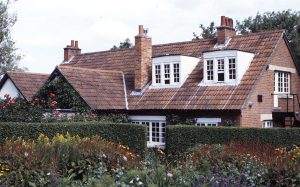
The Kilns
On the east side of the city, close to the Thornhill Park and Ride, is The Kilns, home for over the thirty years to C. S. Lewis (1898-1963). The house lies at the end of a cul-de-sac now called Lewis Close, off Kiln Lane, and can be visited by appointment (OX3 8JD). It is a rambling red-brick building with extensions on both sides, mainly single storey although the central part has a steep roof with dormer windows, forming the attic which featured in moving scenes from Shadowlands.
Lewis and his brother Warren, a retired army officer, led a bachelor existence, looked after by an eccentric housekeeper Mrs Moore. It was here that Lewis conceived the magical world of Narnia, peopled by a strange assortment of witches, elves and talking animals, and it was here in late middle age that he brought Joy Davidman, an American divorcee who admired his writings and eventually became his wife. Their strange courtship and its tragic climax when Joy died of cancer a few years later has been beautifully portrayed on stage and screen.
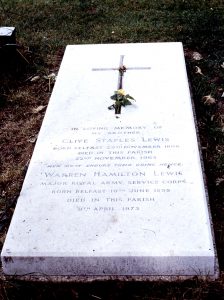
C S Lewis grave
From Lewis's pen came also a string of spiritual classics including Mere Christianity, The Screwtape Letters, and The Problem of Pain. Lewis was the foremost Christian apologist of his time and was said to share with John Bunyan the gift of making righteousness readable.
Across the busy Eastern By-Pass is the area known as Headington Quarry, where former clay pits have left a confusing network of roads, lanes and alleys. At the end of Trinity Road is Holy Trinity Church (OX3 8NU) and here Lewis and his brother Warren lie together in a common grave under a tree. The pew they occupied for thirty years is marked by a brass plaque and adjacent to this is the Narnia window, with scenes from the stories depicted with engraved glass.
DORCHESTER
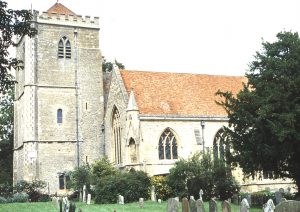
Dorchester Abbey
Dorchester is a picture postcard village with a main street consisting of antique shops, ancient inns and Georgian facades. It was here in 635 that St Birinus a German monk sent by Pope Honorius, baptised King Cynegils of Wessex, with King Oswald of Northumbria standing sponsor. Thus began the dynasty of Christian kings of Wessex, of whom Alfred the Great was the most famous. Birinus was appointed Bishop of Dorchester and Bede records that his missionary efforts were crowned with success and many churches were built in the area. Not long after the death of Birinus in 650, Wessex was under threat of invasion by Mercia and the episcopal and administrative centre of the kingdom was moved from Dorchester to Winchester, together with the body of the saint.
The magnificent Abbey Church of St Peter and St Paul stands on the site of the former Saxon Cathedral (OX10 7HH). It was begun in 1140, with major additions in the 13th and 14th centuries. In the chapel of St Birinus is an exquisite medieval stained glass roundel, apparently showing his ordination by Archbishop Asterius of Milan. The east window also has medieval panel, this time showing Birinus preaching before Cynegils. In the South Choir Aisle is a modern memorial to a twentieth century bishop, made in the form of the medieval shrine of St Birinus.
CROWELL
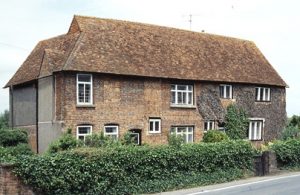
Ellwood House
Lying astride the road between Princes Risborough and the M40 is the tiny hamlet of Crowell with scarcely a dozen houses. The largest of these, helpfully called Ellwood House (OX39 4RR), was the birthplace of Thomas Ellwood (1639-1713), early Quaker, friend of John Milton, intimate of George Fox and William Penn and tutor to the children of Isaac and Mary Pennington. The ivy-covered house faces the road and is privately owned. The odd arrangement of windows suggests many alterations over the years.
Ellwood suffered several periods of imprisonment for his beliefs and, reduced to poverty and near-starvation, was obliged to sell the house of his birth. He is best remembered for snatching the blind John Milton from London in 1665, at the height of the Plague, to a cottage at Chalfont St Giles, and by a chance remark suggesting to him the idea of Paradise Regained.
SOUTH LEIGH
The village is close to Oxford, just off the A40 towards Gloucester. The church of St James the Great is believed to be where John Wesley preached his first sermon as a newly ordained deacon in 1725. What impact he had is unknown as this was thirteen years before his Aldersgate Street conversion. He returned to preach again in 1771 and met a man who had heard him forty-six years before.
The church lies at the end of a cul-de-sac past a pub called the Mason's Arms (OX29 6US). It has some interesting medieval wall paintings and a blue-faced clock with the text Ye know not what hour your Lord doth come.
STANTON HARCOURT
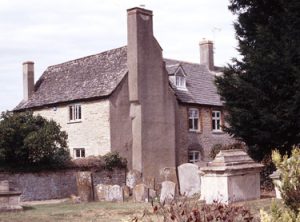
Wesley's cottage
During his regular visits to Oxford, John Wesley would often make excursions to preach at the church here. The vicar John Gambold was one of the few Anglican ministers in sympathy with his views. Eighteen days after his conversion experience in 1738, he preached on the text By grace are you saved through faith and repeated the sermon the same day at St Mary's church, Oxford. The same week he set out for Germany to visit the Moravian community at Herrnhut. The note of revival had been sounded.
St Michael's Church (OX29 5RJ) is filled with memorials to the Harcourt family, the tower of whose former home looms over the churchyard wall. During his visits, Wesley would stay at the cottage on the north side of the churchyard, which served as Gambold's vicarage.
ASHBURY

Thomas Stock's schoolhouse
Lying along country lanes between Swindon and Wantage, this delightful village has a wealth of thatched cottages, mostly clustered around a grassy triangle at the centre. One group in particular has a place in the history of the Sunday School movement. Thomas Stock (1749-1803) came here as curate here in 1777 and began classes for children in the chancel of the church of St Mary the Virgin, where there is a memorial to his work (SN6 8LZ). He later transferred his class to the cottages opposite the gates of Manor Farm in Chapel Lane, the first use of non-church buildings for Sunday School work.
Stock later moved to Gloucester, where he held various appointments, including rector of St John's, and collaborated with Robert Raikes in the development of Sunday Schools as a national movement.


